Home care
The Homecare app is an innovative platform designed to streamline and enhance the caregiving process for both caregivers (helpers) and care receivers.

ROLE & RESPONSIBILITY
UX/UI Designer
User Research, Interaction, Visual Design, Front-end developer
Apr 2024 – Present
OVERVIEW
The Homecare app is an innovative platform designed to streamline and enhance the caregiving process for both caregivers (helpers) and care receivers. Leveraging advanced AI technology, the app automates various aspects of home care, ensuring efficient, personalized, and high-quality support.
MAIN OBJECTIVE
The main objective of the Homecare app is to revolutionize the home care experience by leveraging advanced AI technology to automate routine tasks and enhance personalized care. The app aims to streamline the caregiving process, improve communication, and provide tailored support, thereby ensuring that care receivers receive the highest quality of care while enabling caregivers to deliver their services more efficiently and effectively.
Facilitate seamless and real-time communication between caregivers, care receivers, and team members through secure messaging features, ensuring everyone stays informed and connected. Offer comprehensive reporting and analytics to track the progress of tasks.
Supply caregivers with a robust resource and training videos, enhanced by AI-driven personalized learning recommendations, to ensure they have access to the latest best practices and knowledge in caregiving.
By achieving these objectives, the Homecare app seeks to transform the home care landscape, making it more efficient, personalized, and supportive for both caregivers and care receivers.
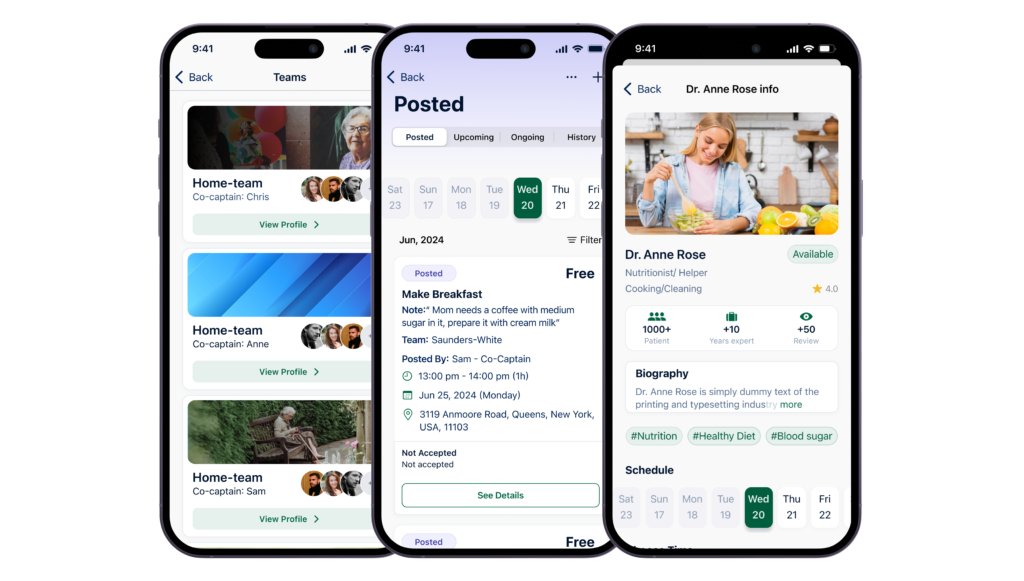
COMPETITIVE ANALYSIS
I conducted a competitive analysis and found that the Homecare app stands out significantly in the market. The comprehensive approach to integrating technology, enhancing communication, and supporting caregivers and care receivers makes the Homecare app a prominent solution in the home care market, offering unparalleled efficiency and personalized care.
REDESIGN PROCESS
Double Diamond Approach
Followed Double Diamond design approach to tackle challenges in four phases: Discover /Research, Define, Develop & Deliver.
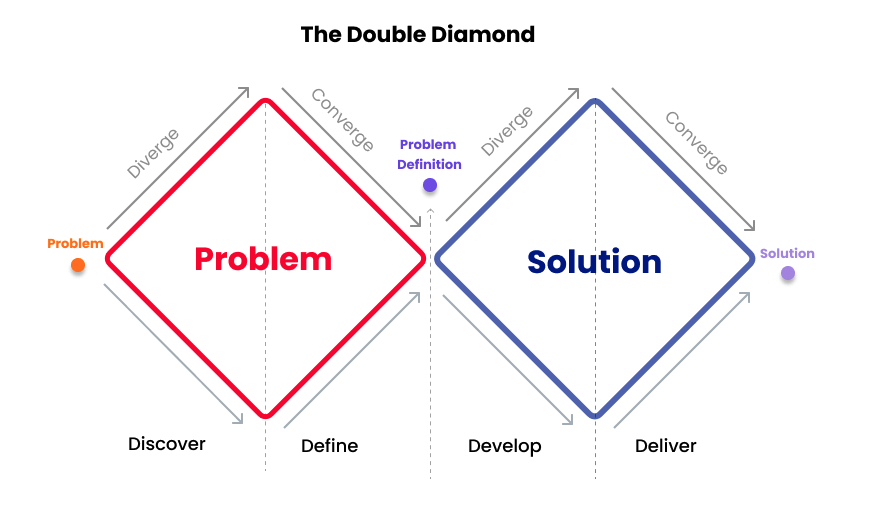
Discovery Phase – Divergent Thinking
During this phase, I aimed to gain a deep understanding of the problem by exploring user and business needs. I conducted internal meetings with stakeholders, senior management, and other relevant teams to uncover valuable insights. This thorough exploration was crucial in developing AI-driven solutions that effectively address the unique challenges faced in home care.Internal Feedback
I arranged face-to-face meetings with relevant teams and the engineering team to gather their perspectives. I also conducted collaborative meetings among different teams to brainstorm ideas and fully understand the dynamics. This process helped me refine the existing functionality of the Homecare app and its AI-driven solutions.
Findings from the internal and customers feedbacks.
The internal team meetings for the Homecare app AI revealed key insights from senior management and engineering teams. Senior management emphasized strategic alignment, user experience, and security, while engineering teams focused on technical feasibility, system integration, performance optimization, and AI implementation mechanisms. Both teams highlighted the importance of AI-driven personalized care plans, automated scheduling, enhanced communication tools, and comprehensive reporting. These insights guided the development and refinement of AI features to ensure the app effectively addresses user needs and enhances the caregiving experience.
Define Phase – Convergent Thinking
At the define phase, I summarized the findings and prioritized the most critical areas that needed to be addressed. I conducted brainstorming sessions to organize and categorize ideas, specifically focusing on enhancing AI integration and user experience. By grouping related concepts, I was able to identify patterns, insights, and potential solutions, ensuring the app’s features were aligned with user needs and business objectives.

Develop Phase – Divergent Thinking
With a clear focus on the problem statement, I entered the development phase. The goal was to leverage our insights to develop multiple AI-driven solutions for enhancing home care and to rigorously test these solutions to validate their effectiveness.
Iteration
Based on our findings, I narrowed my focus to the following areas for improving the Homecare app UI with AI integration:
- Enhance the overall look and feel of the UI.
- Improve the overall user experience.
- Add relevant items to the UI for better engagement and information.
- Make the UI more user-friendly and accessible, especially for older users.
- Automate scheduling, task management, and routine activities to help caregivers for more personalized interactions.
- Use AI to create and adapt individualized care plans based on real-time health data and feedback.
- Facilitate seamless, real-time communication between caregivers, care receivers, and team members with secure messaging.
- Supply caregivers with resources and training videos, enhanced by AI-driven personalized learning recommendations.
Low-Fidelity
With Lo-Fi’s, the general structure of the UI and UX could easily be tested. It is quick and easy to gather everyone’s feedback without much effort, allowing for adjustments before moving into the more costly digital implementation.

Deliver Phase – Convergent Thinking
In the final phase, I developed a hi-fi prototype that presents all the details and functionalities for the Homecare app with AI integration to meet user needs. This phase also involved refining and validating the design solutions through testing and user feedback.
Clickable prototypes
After making adjustments on low-fidelity designs, I created high-fidelity prototypes, supplemented with clickable interactions using Figma. User tests were conducted to validate the structure of the user interface and functionality. Additionally, I gathered feedback, which led to further improvements
Welcome & Splash Screens
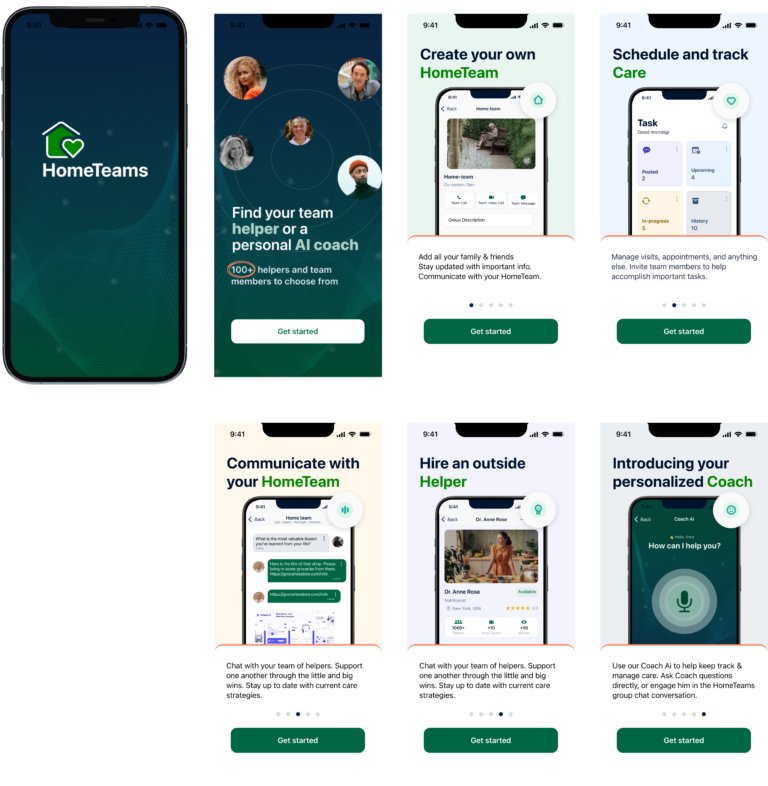
Signup & Login

Onboarding For Team Captain
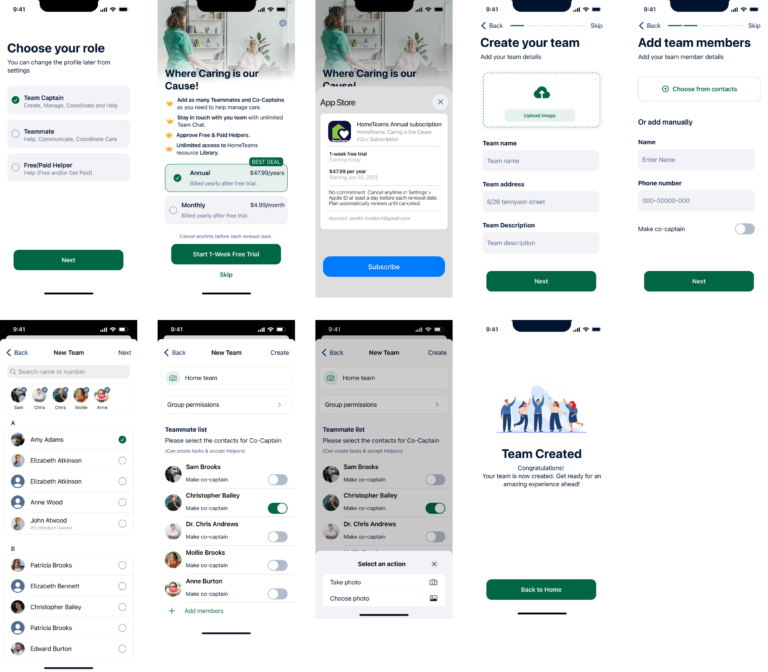
Onboarding For Team Mate

Onboarding For Free/Paid Helpers

Home Page

Group Chat
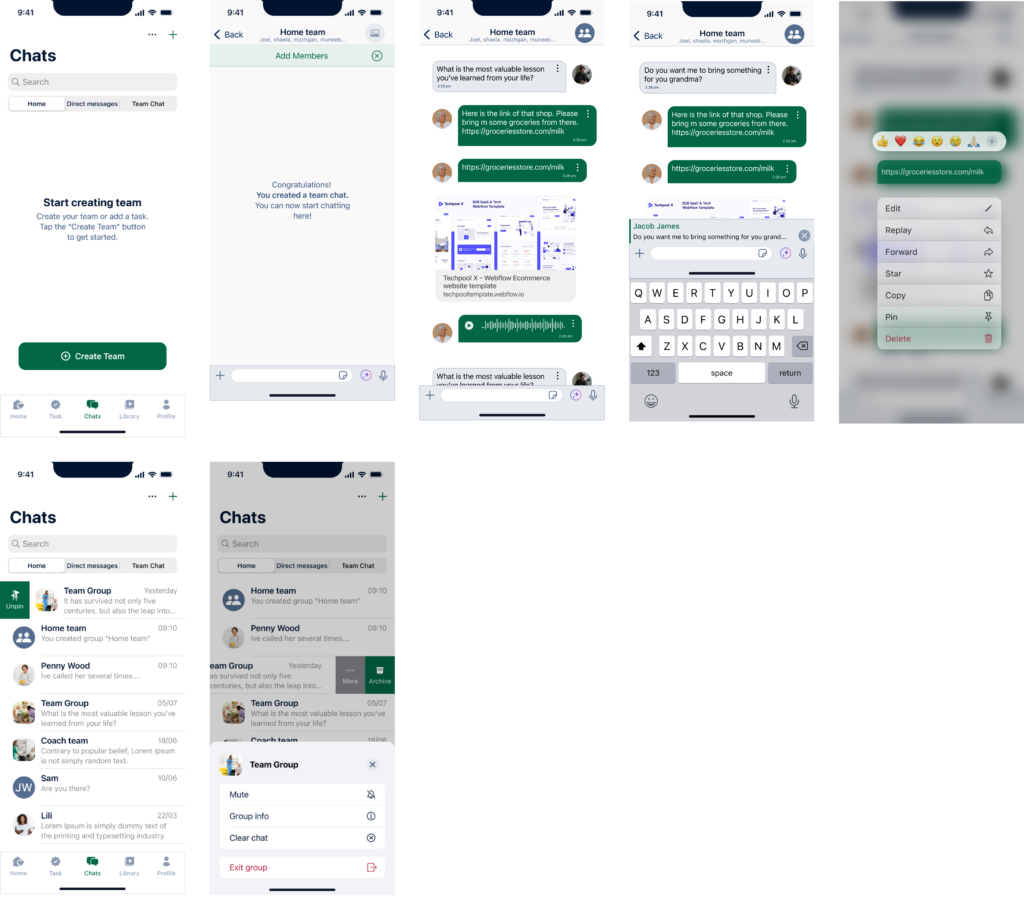
Task Creation

Coach AI

AI in Chat (Work in Progress)

Usability Testing
After developing high-fidelity prototypes, I conducted a usability test to validate the design choices and understand how users would interact with the homecare app’s AI features in a real-world setting. I created a detailed task list and feedback questions to guide the test, and used clickable prototypes on a smartphone to simulate the actual app experience. This helped me observe user behavior and gather insights on how the AI integration could be refined to better meet their needs and enhance their overall experience.
During Test - Think Aloud Protocol
I conducted usability testing for the homecare app’s AI integration using the think-aloud protocol, allowing participants to verbalize their thoughts during task performance. As an observer, I employed an active intervention method, stepping in to assist if participants encountered difficulties or got stuck. This approach provided valuable insights into user interactions with the AI features and helped identify areas for improvement.
Pre-defined tasks
Task 1: Automate Scheduling and Task Management
1. Schedule a new caregiving task using the app.
2. Modify an existing caregiving task.
Task 2: Interact with Legacy AI Module.
1. Record your voice and interact with Legacy AI module.
Task 3: Facilitate Real-Time Communication
1. Send a secure message to your team members group and
suggest anything regarding the task to see how AI will take care of that.
2. Respond to a message from a care giver.
Task 4: Tracking and Analytics
1. Track your ongoing tasks.
Task 5: Access Resources and Training
1. Find and watch a training video on best practices in caregiving.
Feed-back questions
Task 1: Automate Scheduling and Task Management
1. Scheduling a New Caregiving Task:
Q: How clear and straightforward was the process of scheduling a new caregiving task?
Q: Did you encounter any difficulties in selecting the care receiver or setting the date and time?
If so, please describe them?
2. Modifying an Existing Caregiving Task:
Q: How easy was it to locate and edit an existing caregiving task?
Q: Were the options for modifying the task (e.g., time changes, notes) clear and sufficient?
Q: Did the changes save correctly and appear as intended in the task list or calendar?
Task 2: Interact with Legacy AI Module
1. Recording Your Voice and Interacting with Coach AI Module:
Q: How intuitive was the process of recording your voice and interacting with the Legacy AI module?
Q: Did the AI module accurately understand and respond to your voice input? If not, what were the issues?
Q: How well did the AI module address your request or query? Were there any misunderstandings or difficulties?
Task 3: Facilitate Real-Time Communication
1. Sending a Secure Message to Team Members:
Q: How straightforward was it to compose and send a secure message to your team members?
Q: Did you find the feature effective in allowing the AI handle your suggestions?
Q: Were there any issues with message delivery?
2. Responding to a Message from a Care giver:
Q: How easy was it to locate and respond to a message from a care giver?
Q: Was the message interface clear and effective for communication?
Q: Did you experience any problems with message reception or sending a reply?
Task 4: Tracking and Analytics
1. Tracking Ongoing Tasks:
Q: How effective was the task tracking feature in showing the status of your ongoing tasks?
Q: Did you encounter any difficulties in accessing or interpreting the tracking information?
Task 5: Access Resources and Training
1. Finding and Watching a Training Video:
Q: How straightforward was it to locate and access the training video on best practices?
Q: Were there any issues with video playback?
Usability Testing - Responses
Overall participants feedback was positive. I have mentioned summary of feedback from five different users for each of the tasks:
Task 1: Automate Scheduling and Task Management
Scheduling a New Caregiving Task:
User 1: The scheduling process was straightforward, and the interface was easy to follow.
User 2: Scheduling a new task was clear, but the dropdown menus for date and time were confusing at first.
User 3: Found the process intuitive and a calendar view for selecting dates was clear.
User 4: The task scheduling worked well, though some initial guidance on setting up the task would have been helpful.
User 5: Easy to schedule tasks
Modifying an Existing Caregiving Task:
User 1: Editing tasks was easy, but the “edit” button could be more prominent.
User 2: Options for modifying tasks were clear, and changes saved correctly.
User 3: The modification process was simple.
User 4: Found it easy to locate and update tasks, with changes reflecting accurately.
User 5: Modifying tasks was straightforward, though clearer instructions for editing could enhance the experience.
Task 2: Interact with Legacy AI Module
Recording Your Voice and Interacting with Legacy AI Module:
User 1: The voice recording process was intuitive, but the AI sometimes misunderstood specific terms.
User 2: Recording and interacting with the AI was generally easy, though the AI occasionally struggled with complex queries.
User 3: Found the voice interaction feature user-friendly, but the AI’s responses were not always accurate.
User 4: The AI understood most commands well, but there were occasional issues with recognizing names or jargon.
User 5: Interacting with the AI was mostly smooth.
Task 3: Facilitate Real-Time Communication
Sending a Secure Message to Team Members:
User 1: Composing and sending messages was easy, and the AI handled suggestions effectively.
User 2: The messaging feature was straightforward, with no issues in message delivery.
User 3: Found sending secure messages simple, and the AI managed suggestions well.
User 4: Sending messages was clear and efficient, with effective AI handling of task suggestions.
User 5: The process of sending secure messages was smooth, though occasional delays in delivery were noted.
Responding to a Message from a Care Receiver:
User 1: Locating and responding to messages was easy, and the interface was clear.
User 2: The message interface was effective, and there were no issues with sending replies.
User 3: Found it simple to respond to care givers messages, with no problems in message reception.
User 4: The messaging system was clear, making it easy to manage responses.
User 5: Responding to messages was straightforward, though occasional delays in receiving messages were observed.
Task 4: Tracking and Analytics
Tracking Ongoing Tasks:
User 1: Task tracking was effective, but accessing detailed information took some time.
User 2: The task tracking feature worked well.
User 3: Found tracking tasks useful, but better filters could enhance usability.
User 4: The tracking feature provided a clear overview of tasks.
User 5: Effective in showing task statuses.
Task 5: Access Resources and Training
Finding and Watching a Training Video:
User 1: Locating and watching training videos was straightforward with no playback issues.
User 2: Finding and accessing training videos was easy, and playback was smooth.
User 3: The process was clear, and there were no issues with video playback.
User 4: Accessing training videos was simple, though initial search results could be improved.
User 5: Finding and watching videos was easy, and playback worked well throughout.
A/B Testing
Following the positive feedback from our usability testing, I conducted a round of A/B testing to compare the old design with the improved version, now integrated with AI. This testing involved different user groups to determine which design was preferred and which one achieved a higher click-through rate.
Welcome Screen

Signup & Login

Onboarding - Team Captain

Onboarding - Helpers

Group Chat
We have updated the old layout and introduced a “Home” tab in the bottom navigation to display the current status on the homepage. Additionally, we separated the chat from the homepage. In the previous design, there was no homepage.

Task View

A/B Testing Responses
Overall participants feedback was positive. I have mentioned various responses recorded against A/B testing.
- Welcome and Splash: “The new welcome screen feels more engaging, with smoother transitions. It caught my attention immediately, and the colors are more vibrant.”
- Onboarding: “The onboarding was impressive. It felt personalized and quicker than the old version.”
- Signup and Login: “I appreciate the simplicity of the new login screen. It’s less cluttered, and the option to use AI for password recovery is a nice touch.”
- Home: “The layout of the new home screen is more intuitive. The addition of quick overview to key features made navigation easier.”
- Task Creation: “Creating tasks feels more streamlined.”
- Coach AI: “Coach AI is a game-changer. Interaction with AI is impressive.”
- AI in Chat: “AI in chat adds a layer of convenience, suggesting responses and offering help exactly when I need it.”
- Welcome and Splash: “The old splash screen was okay, but the new one feels more modern and professional. It gives a better first impression.”
- Onboarding: “I found the new onboarding process faster. The steps helped me understand the app’s features better.”
- Signup and Login: “Login is now much quicker. The UI is nice.”
- Home: “I like the updated home screen. The design is cleaner, and the recommended helpers on home screen are very useful.”
- Task Creation: “Task creation is now more intuitive. The overall layout of the UI and details speed up the process.”
- Coach AI: ” Coach AI responded to my audio with the right questions. It feels like having a personal assistant within the app.”
- AI in Chat: “AI in chat enhances the conversation flow. I appreciate the smart suggestions that keep the discussion relevant.”
- Welcome and Splash: “The new splash screen is more engaging and visually appealing. It sets a positive tone for the rest of the app.”
- Onboarding: “The onboarding process is smoother.”
- Signup and Login: “I noticed the new login process is faster.”
- Home: “The improved home screen is more organized.”
- Task Creation: “Task creation is more efficient now. AI helps by pre-filling common tasks, which saves time.”
- Coach AI: “Coach AI provides tips that are relevant to my usage patterns. It feels very personalized.”
- AI in Chat: “AI in chat is a great addition. The smart suggestions make conversations more efficient and relevant.”
Participant 4:
- Welcome and Splash: “The new splash screen is vibrant and catches the eye immediately. It’s a big improvement over the old one.”
- Onboarding: “Onboarding with guidance was much quicker and more informative. I understood the app’s features better.”
- Signup and Login: “The new login screen is clean and easy to use.”
- Home: “The home screen is more user-friendly with the new design.”
- Task Creation: “Task creation feels faster now.”
- Coach AI: “Coach AI offers practical advice that aligns with how I use this feature. It’s like having a coach right in the app.”
- AI in Chat: “AI in chat improves communication. The suggestions are relevant and help keep the conversation going.”
Participant 5:
- Welcome and Splash: “The new welcome screen feels more dynamic and engaging. It makes me excited to use the app.”
- Onboarding: “The onboarding process is much more interactive. It feels tailored to my needs.”
- Signup and Login: “The login process is now faster.”
- Home: “I prefer the new home screen layout. The recommendations for helpers are very helpful.”
- Task Creation: “Task creation is quicker with this new UI.”
- Coach AI: “Coach AI’s responses helped me get more out of this feature.”
- AI in Chat: “AI in chat makes communication smoother. The suggestions are helpful and relevant to the conversation.”
DESIGN SYSTEM
The visual design was developed by iterating the previous style guidelines. The brand identity has been taken into the account to give consistent look and feel.

ONGOING ITERATION
We’ve integrated AI at the chat screen level. Currently, we’re working on incorporating AI to automate task creation and provide suggestions and recommendations. In the future, we plan to implement AI throughout the entire app, transforming it into a comprehensive personal assistant.
